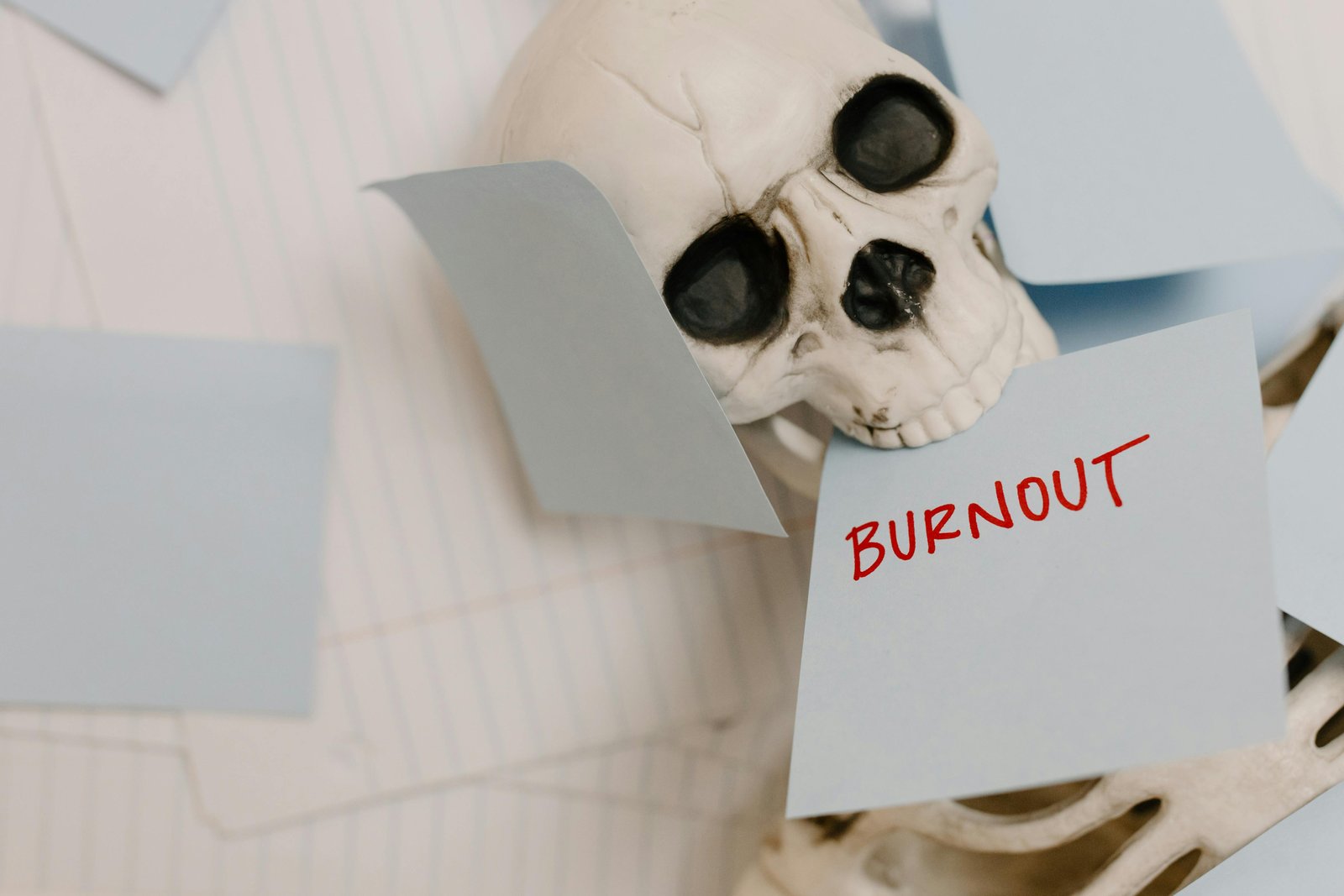Picture this: You wake up to an alarm, already dreading the day ahead. You’re already running late, checking your emails while gulping down coffee, your mind racing with thoughts about deadlines, finances, family responsibilities, and an endless to-do list. Suddenly you start feeling restless and overwhelmed. This overwhelming sensation is stress, something most of us are all too familiar with. As per the American Psychological Association (APA), stress affects nearly 77% of people, resulting in headaches, fatigue, irritability, and even more severe health concerns if left unmanaged.
Sounds familiar? If so, you're not alone. Stress is a universal experience, but it doesn’t have to be a life sentence. The real question isn’t whether we can eliminate stress entirely (spoiler: we can’t), but how we can manage it effectively. The key lies in understanding its root causes.
Knowing the source(s) of your stress is crucial to be able to handling it head-on. Without this awareness, you’re essentially shooting in the dark - attempting to alleviate the symptoms without treating the root problem. Whether it's work, relationships, health, or environmental factors, identifying stress sources or the ‘triggers’ empowers you to address them more effectively and improve your overall quality of life.
This piece will guide you through the complexities of stress, helping you identify its sources and manage it in practical, sustainable ways. We’ll cover:
- Defining what stress is and how it affects your body and mind.
- Identifying common stressors in different aspects of life, such as work, personal relationships, environmental factors, and health issues.
- Self-assessment tools like journaling, mindfulness, and questionnaires to pinpoint stress triggers.
- Develop strategies for managing these stressors, including coping mechanisms, boundary-setting, and seeking support.
- Knowing when to seek professional help and how to maintain long-term stress management through lifestyle choices and self-care.
By the time you finish reading this article, you’ll have the knowledge and tools to take control of your stress and lead a more balanced, fulfilling life.

Let’s Understand Stress
At its core, stress is the body's way of responding to any kind of demand or perceived threat. As you face a tense situation, your body senses it and prepares for a “fight or flight” mode releasing stress hormones such as adrenaline and cortisol. This response was crucial for our ancestors' survival, helping them deal with immediate dangers like predators. In today’s world, however, most stressors are psychological rather than physical, and our body’s stress response can feel disproportionate to the actual threat.
While a small amount of stress can be motivating and even beneficial, chronic stress can wreak havoc on your physical and emotional well-being. Prolonged exposure to stress hormones can lead to adverse effects such as fatigue, anxiety, depression, digestive issues, heart problems, and weakened immune function. Understanding the impact of stress is crucial for recognizing when it becomes harmful and needs to be managed.
Stress and its various types
Stress comes in many forms, and not all stress is bad. In fact, some types of stress can even be beneficial. Let’s look at the breakdown of its three main types:
- Acute Stress: This is the most common form of stress, often triggered by immediate demands or pressures. It can come from a looming deadline, a sudden argument, or getting stuck in traffic. While acute stress can be intense, it usually passes quickly, and in some cases, it can even be helpful in motivating action.
- Chronic Stress: Unlike acute stress, chronic stress is long-term and often stems from ongoing situations such as financial worries, any prolonged physical issue, a difficult relationship, or a demanding job. Chronic stress can have severe consequences on your physical and mental health because your body remains in a constant state of alert. Over time, this wears down your resilience and leads to burnout.
- Eustress (Positive Stress): Believe it or not, not all stress is negative. Eustress refers to positive stress, which can motivate and energize you. Think of the excitement before a big event like a wedding, the thrill of a new challenge at work, or the rush of adrenaline before a big presentation. Eustress helps you grow and adapt to new circumstances, often leading to feelings of fulfillment.
Identifying the Common Sources of Stress
Identifying the sources of your stress is the first step toward effectively managing it. Stress can arise from various aspects of life, and sometimes, it’s a combination of multiple factors. Let’s explore the most common sources of stress.
Work-Related Stress
Workplace stress is one of the most common stressors in modern society. Whether you’re dealing with tight deadlines, heavy workload, or a demanding boss, work-related stress can significantly impact your well-being.
- Workload: The pressure to meet deadlines, handle multiple projects, or juggle various responsibilities can create feelings of overwhelm. Studies have proven, time and again, that excessive workload is one of the leading causes of burnout.
- Job Security: Fear of losing your job, or concerns about job stability can contribute to chronic stress, leaving you constantly worried about your financial future.
- Workplace Relationships: Difficult colleagues or a toxic work environment can add to emotional stress. Interpersonal conflicts or poor communication can create a hostile atmosphere that makes it hard to stay motivated.
Personal Life Stressors
Your personal life is another vital area where stressors are very much in action. Relationships, financial difficulties, and major life changes can all contribute to personal stress.
- Relationships: Tension in romantic relationships, friendships, or family dynamics can create emotional turmoil. Whether it's frequent arguments, lack of communication, or feelings of isolation, stress in relationships can be deeply affecting.
- Finances: Monetary worries are one of the most common sources of stress. Be it living paycheck-to-paycheck, managing debt, or worrying about retirement, financial stress can take a toll on your mental and emotional health.
- Major Life Changes: Significant life events, such as moving, getting married, or having a child, can create stress even if these changes are positive. Adapting to new circumstances takes emotional energy and can trigger feelings of uncertainty.
Environmental Factors
Every now and then, stress comes from external conditions that are beyond our control. Your surroundings can affect your mental health more than you realize.
- Noise: Loud or constant noise, especially in urban areas, can increase stress levels, making it difficult to focus or relax.
- Pollution: Environmental factors like air quality, especially in cities with high pollution, can contribute to stress and physical discomfort.
- Housing Issues: Whether it's dealing with a lack of space, living in an area you dislike, or facing housing instability, your living conditions can add an additional layer of stress.
Health Issues
Physical health problems can be both a cause and a result of stress. Dealing with chronic illness, managing medical appointments, and the uncertainty of your health can create a constant underlying tension.
- Chronic Illness: If you or a loved one is dealing with a long-term health condition, the stress of managing symptoms, medications, and appointments can feel overwhelming.
Physical Symptoms of Stress: Sometimes stress manifests in physical ways, such as headaches, muscle tension, or digestive problems. The longer stress persists, the more likely it is to lead to more severe health problems like high blood pressure or heart disease.

Self-assessment techniques for identifying Stress sources
Before you can manage your stress, you need to understand what triggers it. There are several self-assessment techniques that can help you identify your stress sources more clearly.
Journaling
One of the most effective ways to track your stress is through journaling. Keeping a stress diary allows you to record daily events, thoughts, and feelings, helping you pinpoint what triggers your stress. Over time, patterns may emerge, and you’ll begin to see which situations consistently cause anxiety or frustration.
How to Start: Write down what happened, how you felt, your reaction, and what you think triggered your stress. Include any physical symptoms you experienced, like headaches, change in breathing, or tension. Over time, you’ll start to notice common patterns.
Mindfulness and Reflection
Mindfulness practices, such as meditation or focused breathing, help you stay present and aware of your emotions. Mindfulness allows you to recognize stress triggers as they happen rather than getting swept away by them. By staying attuned to your thoughts and feelings, you can better understand what causes your stress and why certain situations affect you more than others.
Mindfulness Practice: Set aside 10-15 minutes each day to practice mindfulness meditation. Focus on your breathing, and when your mind wanders, gently bring it back to the present. Pay attention to your thoughts without judgment, and observe how certain thoughts or situations trigger stress.
Stress Assessment Tools
There are various online tools and questionnaires designed to help you assess your stress levels and identify stressors. The Perceived Stress Scale (PSS) is one such tool that measures how stressed you feel in your daily life. Other tools may ask about specific areas, such as work or relationships, to help you uncover sources of chronic stress.
Online Resources: Use tools like the Perceived Stress Scale (PSS) or the Holmes-Rahe Stress Inventory, which assigns points to different life events to gauge how much stress you're experiencing.
Now it’s time to analyze your stressors
Once you’ve pinpointed your stress sources, the next step is to analyze them. Understanding the nature of your stressors will help you decide how to address them.
Categorizing Stressors
Not all stressors are created equal, and some are easier to manage than others. Start by categorizing your stressors into different groups:
- Controllable vs. Uncontrollable: Some stressors, like your daily schedule or workload, are within your control, while others, like traffic or weather, are not. Focus your energy on what you can control, and try to let go of what you cannot.
- Work vs. Personal: Identifying whether your stress comes primarily from work or personal life can help you prioritize where to focus your energy.
Assessing Impact
Not all stressors have the same impact on your well-being. Some may cause minor irritations, while others could lead to significant anxiety or even physical symptoms. Assess how each stressor affects you on a daily basis. For example, does a specific stressor leave you feeling exhausted or anxious for hours? Understanding the severity of each stressor helps prioritize what to address first.
- Questions to Consider: How often does this stressor occur? How long does the stress last? How intense is your emotional or physical response to it?
Prioritizing Stressors
Once you’ve categorized and assessed your stressors, you’ll need to prioritize which ones to address first. Focus on high-impact stressors that occur frequently and affect your overall well-being. By tackling the most significant issues first, you’ll notice a bigger difference in your stress levels.
Example Strategy: Use the Eisenhower Matrix, a tool that helps you prioritize tasks based on their urgency and importance. Apply this to your stressors to decide what to tackle first.

Strategies for Managing Identified Stress Sources
Now that you’ve identified and analysed your stressors, it’s time to develop strategies for managing them. From time management techniques to relaxation methods, there are many ways to reduce stress.
Developing Coping Strategies
- Time Management: Understanding and learning the ways to manage your time effectively is one of the best ways to reduce stress, particularly in the workplace. Break larger tasks into smaller, more manageable pieces, and prioritize your most important tasks for the day. Tools like to-do lists or time-blocking methods can help you stay on track and prevent overwhelm.
- Relaxation Techniques: Deep breathing, progressive muscle relaxation, and meditation are all effective ways to reduce stress in the moment. When you feel your stress levels rising, take a few minutes and practice deep breathing, focusing on long, slow inhales and exhales to calm your nervous system.
- Healthy Habits: Maintaining a balanced diet, getting regular exercise, and ensuring you get enough sleep are key to reducing overall stress. Physical health and mental health are closely linked, so when you take care of your body, you also help your mind cope with stress more effectively.
Setting Boundaries
Setting boundaries is essential for managing stress, particularly if it comes from work or relationships. Establishing clear limits on your time and energy helps prevent burnout and protects your mental health. If work is a major stressor, practice saying no to taking on additional tasks when your plate is already full. In personal relationships, communicate your needs and set boundaries around behaviours that eventually escalate your stress level.
- If you find yourself working late into the night, set a firm cut-off time where you stop all work-related activities. Use that time to unwind, disconnect, and focus on self-care.
Seeking Support
Don’t hesitate to reach out to others when you’re feeling stressed. Whether it’s friends, family, or a professional, talking through your stressors can provide relief and perspective. Sometimes, simply sharing your burdens can lighten the load, and others might offer helpful advice or emotional support.
- Social Support: Building a support system of trusted individuals who understand your struggles can make a significant difference in how you cope with stress. Even a quick conversation with a friend can provide emotional relief.
When to Seek Professional Help
Sometimes stress becomes too much to handle alone, and professional help is needed. It’s essential to recognize when your stress has reached a point where it’s affecting your overall well-being and quality of life.
Signs of Severe Stress
If you’re experiencing chronic anxiety, depression, or physical symptoms such as headaches, digestive issues, or insomnia, it may be time to seek professional help. These are signs that your body and mind are struggling to cope with ongoing stress, and without intervention, these symptoms could worsen.
- Physical Symptoms: Headaches, chest pain, continuous feeling of restlessness, heavy breathing, frequent illness, or a general feeling of fatigue and low energy may indicate that stress has taken a toll on your health.
Types of Professionals
Various professionals can assist with stress management, depending on your needs. Here’s a quick guide:
- Doctor: Initially, you can visit a practising medical professional who can diagnose you properly and further advice or refer as required.
- Therapists and Counsellors: Professionals who specialize in cognitive-behavioural therapy (CBT), which is one of the most effective treatments, for stress and anxiety. CBT helps you identify negative thought patterns and reframe them into more positive, productive ones.
- Life Coaches: A life coach can help you set personal or professional goals and develop strategies for managing stress in daily life.
- Psychiatrists: If stress has led to severe anxiety or depression, a psychiatrist can provide medications that may help alleviate symptoms while you work on stress management strategies.
Finding Help
You can find professional help from several sources, ask for recommendations from your primary care doctor, or look for therapists through online directories. Many organizations also offer stress management programs that focus on mindfulness, relaxation techniques, and other coping strategies.

Prevention and Long-Term Stress Management
Managing stress effectively requires ongoing effort and commitment. For managing stress, you need consistent effort and commitment for the same. By making healthy lifestyle choices and prioritizing self-care, you can build resilience and prevent stress from overwhelming you in the future.
Healthy Lifestyle Choices
A healthy lifestyle is your first line of defense against chronic stress. This includes maintaining a balanced diet, getting regular exercise, and ensuring that you get enough sleep each night. When your body is well-nourished and rested, it is better equipped to handle stressors as they arise.
- Exercise: When you engage in physical activity, your body releases endorphins. They are natural stress relievers. Even a 30-minute walk each day can have significant benefits for your mental health.
- Nutrition: Avoid excessive caffeine, sugar, and processed foods, as these can increase feelings of anxiety and stress. Instead of these, you can switch to fruits, fresh vegetables, whole grains, and lean proteins for balanced and wholesome nutrition.
Ongoing Self-Care
To ensure balance and well-being you must practice self-care. This includes taking time to unwind, pursue hobbies, and nurture your relationships. Incorporating regular self-care practices into your routine can help you recharge and prevent burnout.
- Examples of Self-Care: Take time each week to engage in activities you enjoy, whether it’s reading, cooking, spending time with loved ones, or simply taking a break to relax. Prioritize “me time” to ensure you’re taking care of yourself mentally and emotionally.
Building Resilience
Building resilience means developing the ability to bounce back from stressful situations more quickly and with less emotional distress. Resilience is not something you either have or don’t have—it’s a skill that can be developed through positive thinking, problem-solving, and strong social connections.
- How to Build Resilience: Focus on shifting your perspective in stressful situations by asking yourself, “What can I learn from this?” Seek solutions and practical ways to adapt to changes instead of worrying about limitations and problems.
Stress is an inevitable part of life, but by identifying its sources and developing effective strategies to manage it, you can regain control of your well-being. Whether your stress comes from work, personal life, or environmental factors, pinpointing the root causes allows you to tackle the problem at its source.
Remember, stress doesn’t have to define your life. Taking proactive steps to manage and reduce it can improve not only your mental health but your physical health and relationships as well.
Take a moment to reflect on your own stress sources. What has been weighing on you lately? Start keeping track of your stressors, and begin implementing strategies to address them. If you’re feeling overwhelmed, don’t hesitate to seek support or professional help. By making stress management a priority, you can lead a more balanced, peaceful, and fulfilling life.


